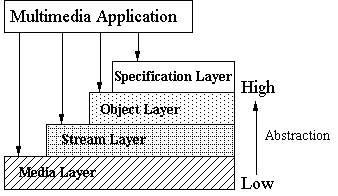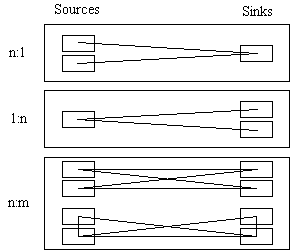CSA402
Lecture 11 - Synchronization in Multimedia Systems
References:
Steinmetz, R., and Nahrstedt, K. (1995). Multimedia:
Computing, Communications & Applications. Prentice Hall. Chapter 15.
Introduction
Synchronization in multimedia systems refers to temporal relationships
between media objects in the multimedia systems. In future multimedia
systems (based, e.g., on MPEG-4) synchronization may also refer to spatial
and content relationships, as well as temporal.
Synchronization between media objects comprises relationships between
time-dependent media objects as well as time-independent media objects.
Synchronization may need to occur at different levels in a multimedia
system, consequently synchronization support is typically found in the
operating system, communication system, databases, multimedia documents,
and the application. A general scheme might involve a layered approach to
achieving synchronization. For example, a Computer-Supported Collaborative
Workgroup (CSCW) session might involved a multi-party video conferencing
session with audio, and a shared whiteboard. Parties may make reference to
objects on the shared whiteboard, using a pointer, to support what they are
saying (e.g., saying "This area here..." while indicating the area with a
pointer). Here, video and audio are continuous media objects which are
highly periodic, whereas the shared whiteboard is a discrete media stream,
as changes to it are highly irregular (the content, including the position
of the pointer, depends on which participant has control of the object and
when they make changes to it). The media streams must be highly
synchronized, so that speech remains lip synchronized, and the whiteboard
updates are synchronized with audio references to them.
The operating system and lower levels of the communication system are
responsible for ensuring that jitter on individual streams does not occur during
presentation of the video, audio, and whiteboard streams (intramedia
synchronization). At a higher
level, the runtime support for the synchronization of multiple multimedia
media streams must ensure that the various media streams remain
synchronized with respect to each other (intermedia synchronization).
Finally, the application(s) are responsible for ensuring
synchronicity between application-level events (usually initiated by the
users). For example, if the application at the source does not capture
timing dependencies between a user waving the pointer over part of the
object in the whiteboard and the supporting audio stream, then it will be
impossible for the application at the sink to know that the whiteboard
and audio events need to be synchronized.
The temporal relations between media objects must be specified during
capture of the media objects, if the goal of the presentation is to present
media in the same way that they were originially captured. Synchronization
information of events in an animation sequence or a slide show is usually
specified by the designer, using, for example, a time-axis.
A Reference Model for Multimedia Synchronization
A reference model is needed to understand the requirements of multimedia
synchronization, identify and structure runtime mechanisms that can
support these requirements, identify interfaces between runtime
mechanisms, and compare solutions for multimedia synchronization systems.
Figure 11.1 shows a reference model for multimedia synchronization systems.
Each layer implements synchronization mechanisms which are provided by an
appropriate interface. These interfaces can be used to specify or enforce
the temporal relationships. Each interface can be used by the application
directly, or by the next higher layer to implement an interface. Higher
layers offer higher programming and QoS abstractions.

Media Layer
An application operates on a single continuous media stream, which is
treated as a sequence of LDUs. Networking components must be taken into
account. Provides access to files and devices.
Stream Layer
The stream layer operates on continuous media streams as well as groups of
media streams. In a group, all streams are presented in parallel by using
mechanisms for interstream synchronization. QoS parameters will specify
intrastream and interstream synchronization requirements.
Continuous media is seen as a data flow with implicit time constraints;
individual LDUs are not visible. An application using the stream layer is
responsible for starting, stopping and grouping the streams, and for the
definition of the required QoS in terms of timing parameters supported by
the stream layer. It is also responsible for the synchronization with
time-independent media objects. Tasks include resource reservation and LDU
process scheduling.
Object Layer
The object layer operates on all media streams and hides the differences
between continuous and discrete media. An application that interacts with
this layer will be presented with a view of a complete, synchronized
presentation. This layer takes a complete synchronization specification as
its input and is responsible for the correct schedule of the overall
presentation.
Specification Layer
This layer contains applications and tools that are allowed to create
synchronization specifications (e.g., authoring tools, multimedia document
editors).
The specification layer is also responsible for mapping user-required QoS
parameters to the qualities offered at the object layer interface.
Synchronization specifications can be:
- Interval-based: specifications of the temporal relations between the time
intervals of the presentation of media objects
- Axes-based: allows presentation events to be synchronized according to
shared axes, e.g., a global timer
- Control flow-based: at specified points in presentations, they are
synchronized
- Event-based: Events in the presentation trigger presentation actions
Synchronization in a Distributed Environment
Synchronization in a distributed environment is complex, because there may
be more than one source of multimedia data, and more than one sink
consuming it. The synchronization information for the various media stream
may also reside at different sources.
Transport of the synchronization specification
The sink needs to have the synchronization information available to
correctly display an object. There are three main approaches to delivering
the synchronization information to the sink:
- Delivery of the synchronization information before the start of the
presentation
- Use of an additional synchronization channel
- Multiplexed data streams
If the multimedia presentation is live and multiple parties are involved,
then none of the approaches above is suitable for delivering
synchronization information to the sink(s) in a timely fashion. Figure 11.2
shows typical communication patterns.

Of particular interest here, is that if multiple sinks are involved, then
they will receive identical data. It would be inefficient if the data were
replicated at the source for separate transmission to each of the sinks. It
would also be inefficient if the same operation was carried out at different
sinks. Multicasting or broadcasting of streams is the responsibility of the stream
layer, whereas efficient planning of operation execution in the different
communication patterns is a responsibility of the object layer.
Multi-Step Synchronization
In a distributed environment, synchronization is typically a multi-step
process, during which the synchronization must be maintained so as to enable
the sink to perform the final synchronization. The synchronization steps are:
- during object acquisition, e.g., during frame digitization
- during retrieval, e.g., synchronized access to frames of a stored video
- during delivery of the LDUs to the network
- during the transport of the LDUs, e.g., using isochronous protocols
- at the sink, e.g., synchronized delivery to the output devices
- within the output device
With many different points at which synchronization must occur decisions
must be made about how to implement it. A first decision is the selection
of the type of transport for the synchronization specification. In
runtime, decisions must be taken concerning the location of
synchronization operations, keeping clocks in synchrony (if used to
provide common timing information), and the handling of multicast and
broadcast messages. Coherent planning of the steps in the synchronization
process, together with the necessary operations of the objects, e.g.,
decompression, must also be done. In addition, presentation manipulation
operations demand additional replanning at runtime.
Synchronization Specification
A synchronization specification should comprise:
- Intra-object synchronization specifications for the media objects of
the presentation
- QoS descriptions for intra-object specifications
- Inter-object synchronization specifications for media objects of the
presentation
- QoS descriptions for inter-object synchronization
In addition, the form, or alternate forms, of a multimedia object may be
described. For example, a text could be presented as text on the screen or
as a generated audio sequence. In the case of live synchronizations, the
temporal relations are implicitly defined during capture. QoS requirements
are specified before the start of the capture. In the case of synthetic
synchronization, the specification must be created explicitly.
Back to the index for this course.
In case of any difficulties or for further information e-mail
cstaff@cs.um.edu.mt
Date last amended: Sunday, 14 March, 1999


